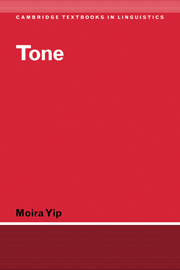Book contents
- Frontmatter
- Dedication
- Contents
- List of figures
- List of maps
- Preface
- Acknowledgements
- Notation systems, symbols and abbreviations
- Glossary of terms and abbreviations
- Alphabetical list of OT constraints
- Maps
- 1 Introduction
- 2 Contrastive tone
- 3 Tonal features
- 4 The autosegmental nature of tone, and its analysis in Optimality Theory
- 5 Tone in morphology and in syntax
- 6 African languages
- 7 Asian and Pacific languages
- 8 The Americas
- 9 Tone, stress, accent, and intonation
- 10 Perception and acquisition of tone
- Bibliography
- Author index
- Subject index
3 - Tonal features
Published online by Cambridge University Press: 05 June 2012
- Frontmatter
- Dedication
- Contents
- List of figures
- List of maps
- Preface
- Acknowledgements
- Notation systems, symbols and abbreviations
- Glossary of terms and abbreviations
- Alphabetical list of OT constraints
- Maps
- 1 Introduction
- 2 Contrastive tone
- 3 Tonal features
- 4 The autosegmental nature of tone, and its analysis in Optimality Theory
- 5 Tone in morphology and in syntax
- 6 African languages
- 7 Asian and Pacific languages
- 8 The Americas
- 9 Tone, stress, accent, and intonation
- 10 Perception and acquisition of tone
- Bibliography
- Author index
- Subject index
Summary
Having described the range of tonal contrasts in the previous chapter, this chapter proposes a feature system for capturing all and only the observed inventories. A good feature system has several desiderata, which are outlined in section 3.1. The following sections deal first with how to represent the number of levels. Since the clearly described systems have no more than a four-way contrast, the system will be based on two binary features, Register and Pitch. How to handle five-tone systems if they exist will also be covered. Next we move on to how to deal with contour tones, and conclude that they should be analysed as sequences of level tones. The reasons for choosing this over a unitary contour alternative will be explained and discussed. This section will be followed by a section on the geometric relation between Register and Pitch (comparing the approaches of, among others, Bao, Clements, Duanmu, Hyman, and Yip), and what sort of data bear on the choice. The penultimate section asks whether tonal features are entirely disjoint from segmental features, focussing mainly on Laryngeal features, but with some discussion of Pharyngeal and Tongue Root features. The chapter will end with the question of whether features are binary or unary, and how we deal with unmarked tones.
Desiderata for a feature system
It has been known for years that the smallest units of phonological structure are not phonemes, or indeed ‘individual sounds’ (if such things exist), but the properties that make up those sounds, stated in terms of distinctive features (or elements in Government Phonology, see Harris 1990).
- Type
- Chapter
- Information
- Tone , pp. 39 - 64Publisher: Cambridge University PressPrint publication year: 2002

